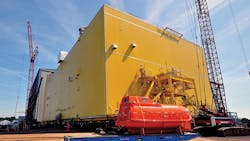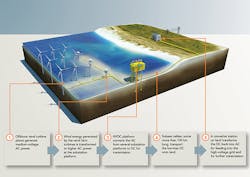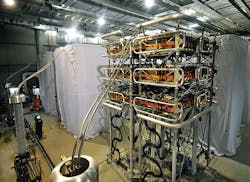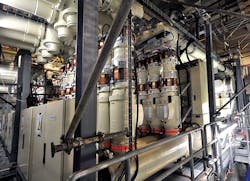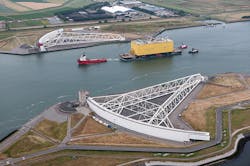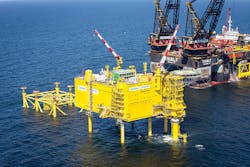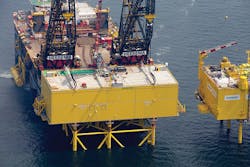The development of offshore wind farms in the North Sea started in 2006, and following the German government’s decision to decommission all nuclear power plants by 2022, the demand for offshore wind farm capacity is now more urgent. The government’s plans call for the installed capacity of offshore wind farms to be 6.5 GW by 2020.
Four offshore wind farm clusters are planned in the North Sea for the integration of wind energy: BorWin, DolWin, HelWin and SylWin. Each has designated subsea cable routes for interconnection to the 400-kV grid. The offshore wind farm statistics show, at present, Germany has 628 MW of offshore wind farm capacity installed, and an additional 2,647 MW of capacity is under construction. The projects in the HelWin cluster are in an advanced stage of construction.
TenneT is the transmission system operator (TSO) in the Netherlands and is the first European cross-border grid-operator for electricity. It is now the largest TSO in Germany with 36 million end users in the Netherlands and Germany supplied via a 21,000 km (13,050 miles) high-voltage network. TenneT is Europe’s first transnational TSO and is ideally located in the center of the European electricity market with existing interconnections to 10 other TSOs.
In accordance with a legal obligation to expand, operate and maintain the power grid on and offshore, TenneT Offshore GmbH (formerly E.ON Netz Offshore and Transpower Offshore GmbH) is contributing to Germany’s long-term major development program by connecting the offshore wind farms in the North Sea to the onshore grid. To date, TenneT has awarded grid-connection capacity of more than 7.1 GW to wind farm developers in a plan that includes nine high-voltage direct-current (HVDC) systems and high-voltage alternating-current (HVAC) systems. Currently, there are four offshore wind power plants in operation and a further eight are under construction.
The HelWin2 Project
Siemens was appointed as the turnkey contractor for the HelWin2 offshore wind farm connecting wind turbines located 85 km (53 miles) offshore in 2015. At first, one of the HVDC offshore grid connections will be used to link the wind farm Amrumbank West to the mainland. Amrumbank West will consist of 80 Siemens wind turbines rated at 3.6 MW and will be located 35 km (21.7 miles) northwest of Helogland and 36 km (22.4 miles) southwest of the island, Amrum.
Tennet awarded the EPC contract for this grid connection in 2011 to a consortium of Siemens and Prysmian Group. It includes marine/civil, mechanical and electrical work. The scope of this contract includes responsibility for the system engineering including the design, supply and installation of the offshore converter, and the platforms, sea and land cable systems as well as the onshore converter station.
Siemens appointed Heerema Fabrication Group as the main subcontractor for design, construction, transportation and installation for the offshore platform. The 690-MW installed transferring capacity is expected to be handed over to TenneT by the first half of 2015.
Design Features
The AC generated by the wind turbines has a voltage output of 690 V that is transformed to 33 kV via the step-up transformer located at the base of the turbine tower. Subsea AC cables are then routed from each wind turbine string to an offshore wind platform. This is a substation that is equipped with gas-insulated switchgear (GIS) and medium-/high-voltage step-up transformers that increase the voltage to 155 kV. Hence, 155-kV subsea AC cables from the wind farm array are then routed from several offshore wind platforms to a single offshore converter station that is equipped with converter transformers, GIS and AC/DC converters for the conversion of the AC voltage to ±320 kV DC. The supplying offshore converter stations are then connected to the mainland counterpart by 320-kV HVDC XLPE submarine and land cables. After reconversion to AC, the power is fed into the existing 400-kV AC transmission system in Germany.
GIS is installed in all the offshore wind platforms and the offshore converter substation. The converter technology developed and used by Siemens is called HVDC Plus, which is essentially a voltage-sourced converter (VSC) of the modular multi-level converter type (VSC MMC). Conventional HVDC technology can only be used on networks with sufficient short-circuit capacity, whereas by using VSC technologies, it is possible to start up islanded networks (black start capability), an important prerequisite for the operation of offshore networks. An additional advantage of HVDC Plus is the production of a nearly sinusoidal AC voltage and a smooth DC voltage. Hence, the converter does not require AC and DC harmonic filters.
The use of HVDC is employed for the offshore to onshore interconnection in preference to HVAC because of the long distance between the offshore wind platform converter station and the onshore interconnection points. High-voltage cable circuits in excess of 80 km (50 miles) in length usually require DC. Generally, HVDC offers several advantages. It provides a “firewall,” preventing the transmission of faults between interconnected HVAC transmission systems. Moreover, HVDC facilitates interconnection of HVAC systems with different frequencies or nonsynchronous operation. The use of AC/DC and DC/AC converter technologies introduces small electrical losses (1%), but the overall system losses for the HelWin2 are still estimated to be less than 4%.
Technical Specification and Construction
The HelWin2 offshore converter substation is located 35 km (21.7 miles) north of Helgoland, the North Sea Island, after which it is named. The HVDC cable route from the offshore converter station to the onshore converter station at Büttel, northwest of Hamburg, is 130 km (81 miles) long: 85 km (53 miles) on the seabed and 45 km (28 miles) on land.
HelWin2 is a “daughter” platform to the already installed “mother” platform HelWin1, erected by Siemens in 2013, which is installed 30 m (98 ft) away. This means that HelWin2 will be able to share facilities only installed in the mother platform such as the helideck, crew quarters and cables. A pedestrian bridge that is designed for access and to carry 155-kV AC cables and auxiliary cables provides the link between the two platforms. Several 155-kV AC cables are installed on the bridge to allow for the transmission of wind power via the other platform in the event of one platform not operating.
Marine/Civil
The foundation designed to support the converter substation is positioned in the sea in an area with a depth of 24 m (79 ft). This foundation is comprised of six steel pilings that are 119 m (390 ft) long, 2.4 m (7.87 ft) in diameter and with a wall thickness of 8 cm (3.15 inches). Each piling is embedded up to 69 m (226 ft) into the seabed. The foundation was fabricated in the Heerema Shipyard in the Netherlands. The platform and the foundation weighs 7,500 tons (6,804 tonnes) and was installed and anchored to the seabed using ‘Thialf,’ the world’s largest crane vessel, in 2014.
Electrical Specification
The offshore converter platform is in a steel container 98 m long × 42 m wide × 26 m high (323 ft × 138 ft × 85 ft) designed with seven decks including the upper deck. A single loading crane (10-ton [9-tonne] capacity) is mounted on the upper deck increasing the height of the container to 40 m (131 ft). The total weight of the container is 10,500 tons (9,525 tonnes), and it is mounted on the foundation 24 m (79 ft) above sea level.
The core of the container houses power-conversion equipment manufactured by Siemens that includes 320-kV GIS switchgear, two 508-MVA HVDC transformers, HVDC converters, reactors, protection and control equipment. The substation emergency power supplies are provided by a 625-kVA diesel generator, and the UPS units installed are two 250-kVA and two 80-kVA units. Substation cooling is provided by seawater with a heat exchanger supplying the fresh-water cooling system that has a flow-rate of 1,370 cu meters per hour (48,375 cu ft per hour). The fabrication of the platform was finalized during 2014 when Siemens installed and precommissioned tested the complete offshore converter station.
Offshore Platform Construction
The HelWin2 offshore platform load-out operation started in June 2014. The unit was loaded onto a seagoing barge for transportation along the River Oude Mass to Schiedam near Rotterdam. Following completion of the sea-fastening operations and installation of the top-deck-mounted crane, the platform was transported to the installed foundaiton. The heavy-lift crane ship Thiaf lifted the platform from the barge onto the installed foundation, ready for welding the two sections together.
The platform is fully automated, and once commissioned, the complete installation can be monitored and controlled remotely with cameras and sensors providing a complete overview of the current operating status. The crew’s quarters on HelWin1 platform can be used when maintenance is required, and Siemens has been contracted by TenneT for the maintenance of the HelWin2 installation for an initial period of five years. The next construction stages include connection of the subsea AC cables to the converter station and the HVDC submarine cables to complete the link to the onshore converter station.
Cable Installation
The HVAC 155-kV submarine cables between the wind farms AC platforms and the HVDC offshore converter station was manufactured by Prysmian. The seabed installation is concluding. The HVDC submarine cable was installed by Prysmian’s cable-laying vessel ‘Atalanti’ whereas AC cables will be installed by Prysmian’s cable-laying vessel ‘Giulio Verne.’ The HVDC cables between the offshore and onshore converter station is made up of three sections: offshore, shallow water/Wadden Sea, and onshore land. The selected two ±320-kV HVDC XLPE-insulated cables with steel-wire reinforcement establish a new world record as one of the first HVDC XLPE-insulated cables installed with a voltage exceeding ±300 kV.
Specification for the cable sections is as follows:
• North Sea: 68 km (42.3 miles) long; copper conductors, cross-sectional area 800 sq mm ( 1.24 sq inches); cable diameter 12 cm (4.72 in); weight 31.5 kg/m (21.2 lb/ft)
• Wadden Sea: 17 km (10.6 miles) long; copper conductors, cross-sectional area 1,100 sq mm (1.71 sq inches); cable diameter 13 cm (5.12 inches); weight 36.5 kg/m (24.5 lb/ft)
• Land: 46 km (28.6 miles) long; aluminium conductors, cross-sectional area 1,800 sq mm (2.79 sq in); cable diameter 12 cm (4.72 in); weight 13 kg/m (8.74 lb/ft).
The Wadden Sea area is a UNESCO–World Heritage Site, so the offshore cable-laying and burial methods had to comply with strict requirements. To provide the converter station’s remote protection and control facilities, fiber-optic cables were installed between the offshore and onshore converter stations.
Construction Timetable
The contract for HelWin2 was awarded in 2011. The multi-stage construction timetable started with platform design and engineering as well as initiation of the many phase construction and installation permit processes. Fabrication of the platform and the construction of the onshore converter station was next, followed by equipping the platform, and installing the foundation and the offshore platform. Finally, the complete installation is subject to commissioning prior to commercial operation, which, for HelWin2, should commence in the first half of 2015. Based on experience and the logistics involved with offshore projects, the execution time is possibly four years, but in the event of bad weather, this can increase to five years.
Offshore Wind Energy
The benefit of installing wind turbines offshore is the potential significantly higher energy production. Offshore wind farms have been in operation for almost two decades with a recorded reliability of 97%. The service life of these wind farms is 20 years, but the design life of the electrical components is considerably longer.
Manufacturers have already substantially increased the overall size and unit capacity of wind turbines, but offshore wind energy is currently considered to be amongst the most expensive form of renewable energy. Hence, to reduce the capital investment associated with this technology, significant changes in the overall dimensions of the platform and the design of the electrical equipment installed in the converter station are already in the pipeline.
To date, the installed capacity of each offshore DC grid connection has varied. However, all parties now involved with the German offshore wind energy program have now agreed that the installed capacity of all future offshore DC links will be standardized at 900 MW, with sea-to-shore DC cables having a voltage of ±320 kV. This standardization measure is also expected to contribute to the efforts being made to drive-down the overall cost-per-megawatt capacity installed.
Future Development
Germany plans significant expansion of offshore wind power. The HVDC systems from the offshore converter stations are being used to supply the existing HVAC north-to-south energy highways. The current offshore wind farm program is to install 6.5 GW by 2020 and another 8.5 GW by 2030. The expansion potential is estimated to be 23 GW. Subject to these targets being met, the offshore wind share in energy production in Germany will be 4% by 2020 and 10% by 2030.
Acknowledgement
The author wishes to acknowledge the support and assistance received from the staff from TenneT, Siemens, Prysmian and Heerema during his 2014 visit to the Heerema Shipyard.
Mentioned in this article:
Heerema Fabrication Group | hfg.heerema.com
Prysmian Group | prysmiangroup.com
Siemens | www.siemens.com
TenneT Offshore GmbH | www.tennet.eu
About the Author
Gerry George
Gerry is a chartered electrical engineer and a member of the Institution of Electrical Engineers. Gerry’s background includes extensive time and experience in engineering and managerial positions in the UK Supply Industry. As part of the T&D World editorial team, Gerry works with contributing authors around the world and represents the magazine at major transmission and distribution conferences and exhibitions in Europe.
